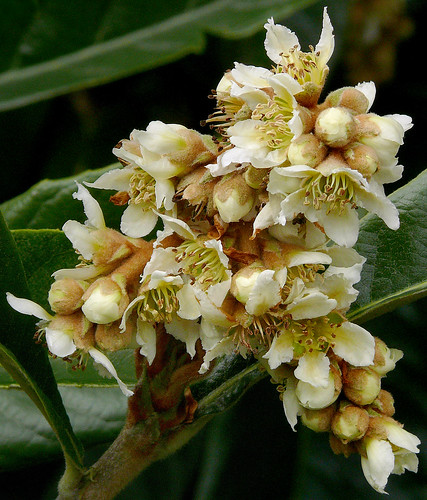what is swamp cabbage, as a botanical?
what is swamp cabbage?
inflorescence best answer:
Answer by happycamper
It is another name for the skunk cabbage, which belongs to the symplocarpus genus (s.foetidus). Foetidus means smelly.
inflorescence
Eriobotrya japonica #2

Best viewed @ large size
Rosaceae - Indigenous to S. China
Loquat
Shown: Detail of inflorescence displaying flower buds and fully opened flowers
"The Loquat is a fruit of Southeastern Chinese origin. It was introduced into Japan and became naturalised there in very early times, and has been cultivated there for over 1,000 years. It has also become naturalised in India, the whole Mediterranean Basin and many other areas. Chinese immigrants are presumed to have carried the loquat to Hawaii.
"It is an evergreen large shrub or small tree, with a rounded crown, short trunk and woolly new twigs. The tree can grow to 5-10 m tall, but is often smaller, about 3-4 m.
"The leaves are alternate, simple, 10-25 cm long, dark green, tough and leathery in texture, with a serrated margin, and densely velvety-hairy below with thick yellow-brown pubescence; the young leaves are also densely pubescent above, but this soon rubs off.
"Loquats are unusual among fruit trees in that the flowers appear in the autumn or early winter, and the fruits are ripe in late winter or early spring. In Northern California, loquats bear fruit in May, while in Southern California, loquats bear fruit in April. The flowers are 2 cm diameter, white, with five petals, and produced in stiff panicles of three to ten flowers. The flowers have a sweet, heady aroma that can be smelled from a distance.
"Loquat fruits, growing in clusters, are oval, rounded or pear-shaped, 3-5 cm long, with a smooth or downy, yellow or orange, sometimes red-blushed skin. The succulent, tangy flesh is white, yellow or orange and sweet to subacid or acid, depending on the cultivar. Each fruit contains five ovules, of which one to five mature into large brown seeds. The skin, though thin, can be peeled off manually if the fruit is ripe." (Wikipedia)
My additional image of E. japonica:
www.flickr.com/photos/jim-sf/4311525944/in/photostream/
Photographed in U.C. Botanical Garden at Berkeley - Berkeley, California
Orignal From: what is swamp cabbage, as a botanical? and Eriobotrya japonica #2
No comments:
Post a Comment